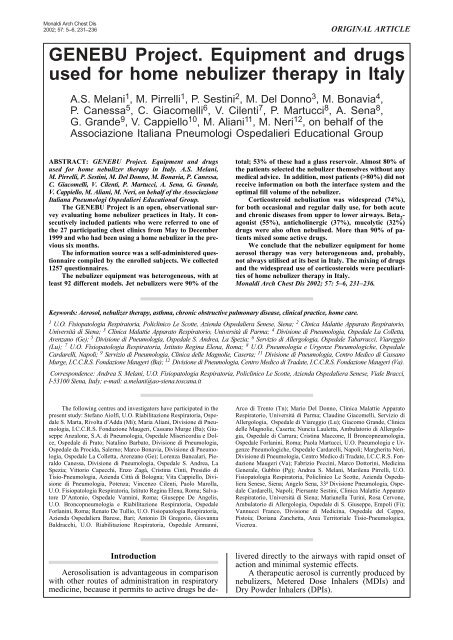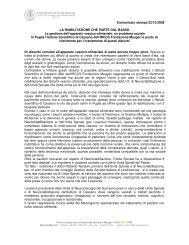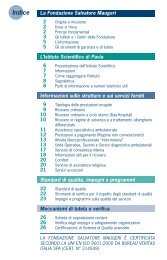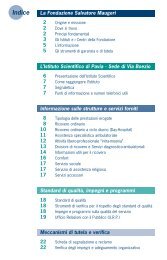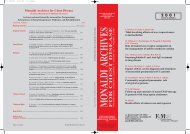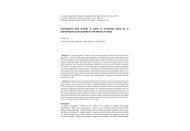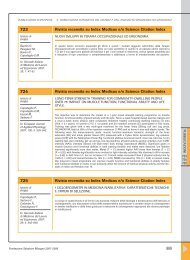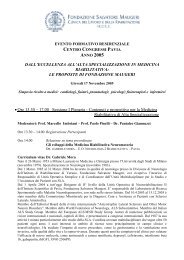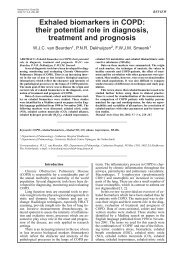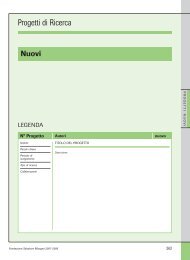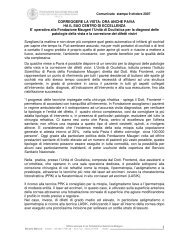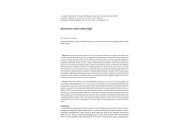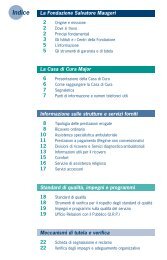01 melani xp - Fondazione Salvatore Maugeri
01 melani xp - Fondazione Salvatore Maugeri
01 melani xp - Fondazione Salvatore Maugeri
You also want an ePaper? Increase the reach of your titles
YUMPU automatically turns print PDFs into web optimized ePapers that Google loves.
Monaldi Arch Chest Dis<br />
2002; 57: 5–6, 231–236 ORIGINAL ARTICLE<br />
GENEBU Project. Equipment and drugs<br />
used for home nebulizer therapy in Italy<br />
A.S. Melani 1 , M. Pirrelli 1 , P. Sestini 2 , M. Del Donno 3 , M. Bonavia 4 ,<br />
P. Canessa 5 , C. Giacomelli 6 , V. Cilenti 7 , P. Martucci 8 , A. Sena 8 ,<br />
G. Grande 9 , V. Cappiello 10 , M. Aliani 11 , M. Neri 12 , on behalf of the<br />
Associazione Italiana Pneumologi Ospedalieri Educational Group<br />
ABSTRACT: GENEBU Project. Equipment and drugs<br />
used for home nebulizer therapy in Italy. A.S. Melani,<br />
M. Pirrelli, P. Sestini, M. Del Donno, M. Bonavia, P. Canessa,<br />
C. Giacomelli, V. Cilenti, P. Martucci, A. Sena, G. Grande,<br />
V. Cappiello, M. Aliani, M. Neri, on behalf of the Associazione<br />
Italiana Pneumologi Ospedalieri Educational Group.<br />
The GENEBU Project is an open, observational survey<br />
evaluating home nebulizer practices in Italy. It consecutively<br />
included patients who were referred to one of<br />
the 27 participating chest clinics from May to December<br />
1999 and who had been using a home nebulizer in the previous<br />
six months.<br />
The information source was a self-administered questionnaire<br />
compiled by the enrolled subjects. We collected<br />
1257 questionnaires.<br />
The nebulizer equipment was heterogeneous, with at<br />
least 92 different models. Jet nebulizers were 90% of the<br />
Keywords: Aerosol, nebulizer therapy, asthma, chronic obstructive pulmonary disease, clinical practice, home care.<br />
1 U.O. Fisiopatologia Respiratoria, Policlinico Le Scotte, Azienda Ospedaliera Senese, Siena; 2 Clinica Malattie Apparato Respiratorio,<br />
Università di Siena; 3 Clinica Malattie Apparato Respiratorio, Università di Parma; 4 Divisione di Pneumologia, Ospedale La Colletta,<br />
Arenzano (Ge); 5 Divisione di Pneumologia, Ospedale S. Andrea, La Spezia; 6 Servizio di Allergologia, Ospedale Tabarracci, Viareggio<br />
(Lu); 7 U.O. Fisiopatologia Respiratoria, Istituto Regina Elena, Roma; 8 U.O. Pneumologia e Urgenze Pneumologiche, Ospedale<br />
Cardarelli, Napoli; 9 Servizio di Pneumologia, Clinica delle Magnolie, Caserta; 11 Divisione di Pneumologia, Centro Medico di Cassano<br />
Murge, I.C.C.R.S. <strong>Fondazione</strong> <strong>Maugeri</strong> (Ba); 12 Divisione di Pneumologia, Centro Medico di Tradate, I.C.C.R.S. <strong>Fondazione</strong> <strong>Maugeri</strong> (Va).<br />
Correspondence: Andrea S. Melani, U.O. Fisiopatologia Respiratoria, Policlinico Le Scotte, Azienda Ospedaliera Senese, Viale Bracci,<br />
I-53100 Siena, Italy; e-mail: a.<strong>melani</strong>@ao-siena.toscana.it<br />
The following centres and investigators have participated in the<br />
present study: Stefano Aiolfi, U.O. Riabilitazione Respiratoria, Ospedale<br />
S. Marta, Rivolta d’Adda (Mi); Maria Aliani, Divisione di Pneumologia,<br />
I.C.C.R.S. <strong>Fondazione</strong> <strong>Maugeri</strong>, Cassano Murge (Ba); Giuseppe<br />
Anzalone, S.A. di Pneumologia, Ospedale Misericordia e Dolce,<br />
Ospedale di Prato; Natalino Barbato, Divisione di Pneumologia,<br />
Ospedale da Procida, Salerno; Marco Bonavia, Divisione di Pneumologia,<br />
Ospedale La Colletta, Arenzano (Ge); Lorenza Bancalari, Pieraldo<br />
Canessa, Divisione di Pneumologia, Ospedale S. Andrea, La<br />
Spezia; Vittorio Capecchi, Enzo Zagà, Cristina Cinti, Presidio di<br />
Tisio-Pneumologia, Azienda Città di Bologna; Vita Cappiello, Divisione<br />
di Pneumologia, Potenza; Vincenzo Cilenti, Paolo Marolla,<br />
U.O. Fisiopatologia Respiratoria, Istituto Regina Elena, Roma; <strong>Salvatore</strong><br />
D’Antonio, Ospedale Vannini, Roma; Giuseppe De Angelis,<br />
U.O. Broncopneumologia e Riabilitazione Respiratoria, Ospedale<br />
Forlanini, Roma; Renato De Tullio, U.O. Fisiopatologia Respiratoria,<br />
Azienda Ospedaliera Barese, Bari; Antonio Di Gregorio, Giovanna<br />
Baldracchi, U.O. Riabilitazione Respiratoria, Ospedale Armanni,<br />
Introduction<br />
Aerosolisation is advantageous in comparison<br />
with other routes of administration in respiratory<br />
medicine, because it permits to active drugs be de-<br />
total; 53% of these had a glass reservoir. Almost 80% of<br />
the patients selected the nebulizer themselves without any<br />
medical advice. In addition, most patients (>80%) did not<br />
receive information on both the interface system and the<br />
optimal fill volume of the nebulizer.<br />
Corticosteroid nebulisation was widespread (74%),<br />
for both occasional and regular daily use, for both acute<br />
and chronic diseases from upper to lower airways. Beta 2 -<br />
agonist (55%), anticholinergic (37%), mucolytic (32%)<br />
drugs were also often nebulised. More than 90% of patients<br />
mixed some active drugs.<br />
We conclude that the nebulizer equipment for home<br />
aerosol therapy was very heterogeneous and, probably,<br />
not always utilised at its best in Italy. The mixing of drugs<br />
and the widespread use of corticosteroids were peculiarities<br />
of home nebulizer therapy in Italy.<br />
Monaldi Arch Chest Dis 2002; 57: 5–6, 231–236.<br />
Arco di Trento (Tn); Mario Del Donno, Clinica Malattie Apparato<br />
Respiratorio, Università di Parma; Claudine Giacomelli, Servizio di<br />
Allergologia, Ospedale di Viareggio (Lu); Giacomo Grande, Clinica<br />
delle Magnolie, Caserta; Nuncia Lauletta, Ambulatorio di Allergologia,<br />
Ospedale di Carrara; Cristina Maccone, II Broncopneumologia,<br />
Ospedale Forlanini, Roma; Paola Martucci, U.O. Pneumologia e Urgenze<br />
Pneumologiche, Ospedale Cardarelli, Napoli; Margherita Neri,<br />
Divisione di Pneumologia, Centro Medico di Tradate, I.C.C.R.S. <strong>Fondazione</strong><br />
<strong>Maugeri</strong> (Va); Fabrizio Peccini, Marco Dottorini, Medicina<br />
Generale, Gubbio (Pg); Andrea S. Melani, Marilena Pirrelli, U.O.<br />
Fisiopatologia Respiratoria, Policlinico Le Scotte, Azienda Ospedaliera<br />
Senese, Siena; Angelo Sena, 33 a Divisione Pneumologia, Ospedale<br />
Cardarelli, Napoli; Piersante Sestini, Clinica Malattie Apparato<br />
Respiratorio, Università di Siena; Marianella Turini, Rosa Cervone,<br />
Ambulatorio di Allergologia, Ospedale di S. Giuseppe, Empoli (Fi);<br />
Vannucci Franco, Divisione di Medicina, Ospedale del Ceppo,<br />
Pistoia; Doriana Zanchetta, Area Territoriale Tisio-Pneumologica,<br />
Vicenza.<br />
livered directly to the airways with rapid onset of<br />
action and minimal systemic effects.<br />
A therapeutic aerosol is currently produced by<br />
nebulizers, Metered Dose Inhalers (MDIs) and<br />
Dry Powder Inhalers (DPIs).
Nebulizers are cumbersome, time-consuming<br />
and not very efficient, and as a result many physicians<br />
consider them as a second-choice for delivering<br />
an aerosol therapy. Although not extensively<br />
evaluated in the literature [1–3], many patients<br />
prefer nebulizers in home clinical practice.<br />
Nebulizers have been used for many years to<br />
deliver bronchodilator, corticosteroid, antibiotic and<br />
mucolytic drugs [1–3], but their use seems to vary<br />
largely between different countries. In 1992, an international<br />
asthma survey was carried out by chest<br />
physicians from 19 European countries. Vermeire<br />
found [4] that β 2 -agonists were the most commonly<br />
nebulised drugs, but corticosteroid, anticholinergic<br />
and mucolytic drugs were also used; corticosteroids<br />
were seldomly employed in U.K., but were more<br />
common in Germany, Austria and Switzerland; mucolytic<br />
drugs appeared mainly utilised in the<br />
Eastern Europe, but also in Germany and Austria.<br />
Guidelines stress that the nebulizer equipment<br />
largely influences the dose of active drug delivered<br />
to the airways [1–3]. However, to our knowledge,<br />
no nation-wide survey has investigated what<br />
equipment is used for home nebulizer therapy in<br />
clinical practice and whether the choice of nebulizer<br />
equipment depends on both the appropriate<br />
airway target site and the characteristics of the<br />
nebulised solution.<br />
The AIPO (Italian Association of Hospital<br />
Pneumologists) Educational Group has carried out<br />
the GENEBU (Gruppo Educativo per i NEBUlizzatori)<br />
Project with the aim of evaluating home<br />
nebulizer practices in Italy. This survey analyses<br />
the current equipment and the most commonly<br />
used drugs with relative dosages for home nebulizer<br />
therapy. It also evaluates the patients’ perceived<br />
effectiveness of nebulizer therapy and the<br />
comparison with other inhalers in terms of effectiveness,<br />
ease of use and personal preference.<br />
Material and methods<br />
The GENEBU Project is an open, cross-sectional,<br />
observational study carried out in 27 Respiratory<br />
Centres throughout Italy, from 1st May to<br />
31st December 1999. Although the enrolment of<br />
investigators was voluntary, the participating centres<br />
encompassed several geographical and environmental<br />
conditions, therefore, we believe that<br />
this survey has a nation-wide value (see centres<br />
listing in footnote 1).<br />
The design of the GENEBU Project has been<br />
extensively described elsewhere [5]. Briefly, during<br />
the study period, all the patients who were referred<br />
to one of the participating centres, were and<br />
had been using a home nebulizer in the six months<br />
prior to the enrolment and agreed to take part in<br />
this study, giving written informed consent, were<br />
included. Once enrolled, all the patients compiled<br />
a self-administered questionnaire on their home<br />
nebulizer practices. The diagnosis of the respiratory<br />
disease, written from the investigators, was the<br />
only exception to self-compilation.<br />
The present manuscript includes the results to<br />
some close-ended answers mainly on both the per-<br />
232<br />
A.S. MELANI ET AL.<br />
ceived effectiveness of nebulizer therapy to relieve<br />
symptoms and the comparison with other inhalers<br />
in terms of effectiveness, ease of use and personal<br />
preference. It also includes some open answers,<br />
which analysed the model of the current nebulizer<br />
equipment and the nebulised solution with the initial<br />
fill volume, and the dosages of active drugs.<br />
Chi square statistics and multiple logistic regression<br />
were used for the analysis of categorical<br />
variables. Unless stated otherwise, all logistic<br />
models included gender, age and presence of bronchopulmonary<br />
diseases to adjust to these possible<br />
confounders. A p value of 0.05 or less for a two<br />
tailed test was considered as significant. Data<br />
analysis was performed using the Stata v7.0 program<br />
(Stata corp., College Station, TX, USA).<br />
Results<br />
1,157 subjects answered and returned the<br />
questionnaire. Almost 90% of patients mainly suffered<br />
from bronchopulmonary diseases and the remaining<br />
ones (10.3%) only of upper airways diseases.<br />
Almost 95% of the patients with bron-<br />
Table 1. – The most common types of nebulizers<br />
Type of nebulizer No.<br />
Artsana Project II ultrasound 53<br />
Artsana jet unspecified 44<br />
Artsana Record jet type diaphragm compressor 10<br />
Alleanza e Salute jet unspecified 13<br />
Atomizer 3A Elettromedicali unspecified 10<br />
CAMI Pharmasol jet type diaphragm compressor 12<br />
Farmac-Zabban Zeta-Sol jet type diaphragm<br />
compressor 20<br />
Farmac-Zabban Neosol jet type rotary piston<br />
compressor 11<br />
FLAEM Linea F Angelini jet type diaphragm<br />
compressor 117<br />
FlAEM Universal II ultrasound 22<br />
Ico Air Lister Rapid ultrasound 10<br />
Ico Air Lister Plus unspecified 15<br />
Ico Air Lister 2000 jet type diaphragm<br />
compressor 45<br />
IMETEC jet unspecified 26<br />
Markos Mobyneb jet type rotary piston<br />
compressor 10<br />
Markos Nebula jet type rotary piston compressor 167<br />
Markos Soffio jet type rotary piston compressor 47<br />
Medel Aerofamily jet type rotary piston<br />
compressor 25<br />
Medel Microlux jet type diaphragm compressor 35<br />
Medel Microgen jet type diaphragm compressor 14<br />
Nord Italia Elettromedicali Constellation jet<br />
unspecified 14<br />
Nord Italia Elettromedicali Concorde jet<br />
unspecified 10<br />
Nucleo Pharma Mercury Super jet unspecified 16<br />
Pari Boy LC Plus jet type rotary piston<br />
compressor 9<br />
Others 335
GENEBU PROJECT. EQUIPMENT AND DRUGS USED FOR HOME NEBULIZER THERAPY IN ITALY<br />
chopulmonary diseases had chronic problems,<br />
such as COPD (46%) and bronchial asthma (31%).<br />
In Italy patients needing a home nebulizer,<br />
took charge of their the device directly. Just under<br />
80% of patients made a decision regarding their<br />
nebulizer equipment, without any advise from the<br />
prescribing physician. One thousand and ninetynine<br />
patients reported the model name of their nebulizer:<br />
ninety-two different models were reported<br />
at all, being the most common ones reported in<br />
table 1. Jet nebulizers were the most commonly<br />
used systems, but ultrasound ones accounted for<br />
around 7% of the total. Ultrasound nebulizers were<br />
similarly diffused between patients with upper and<br />
lower airways disease, as well as between those<br />
with occasional (less than 60 days per year) and<br />
regular daily use (6.9% vs. 6.5%). Most patients<br />
powered the jet nebulizer using a compressor; approximately<br />
half of the specified compressors<br />
were rotary piston types, and the others, diaphragm<br />
ones, with no difference between patients<br />
with prevalent lower or upper airways diseases. A<br />
few subjects (9.7%) used oxygen as a source of<br />
compressed gas for nebulisation and more often<br />
were patients suffering with bronchopulmonary<br />
disturbances (10.6% vs. 1.2%, p
BDP, nebulised either alone or mixed to bronchodilators.<br />
The mean total volume of the solution into the<br />
reservoir before starting nebulisation was 3.5 ± 1.2<br />
ml. (mean ± SD), without any significant difference<br />
at least for the most commonly used types of<br />
jet nebulizer. Although the initial volume of solution<br />
varied largely, it did never resulted in less than<br />
2.5 ml for single nebulisation. Forty-three per cent<br />
of patients added physiologic saline to active<br />
drugs, 5.1% distilled water, 1.8% tap water, while<br />
the remaining ones did not add any solvent to the<br />
234<br />
Table 3. – Some modalities of use for nebulised drugs<br />
A.S. MELANI ET AL.<br />
Drug Use for broncho- Use only for upper Occasional Regular daily<br />
pulmonary diseases airways diseases use* use<br />
Steroids 77.7 61.5°° 71.2 85.2°°<br />
Antibiotics 3.4 11.3° 6.1 1.8°°°<br />
Mucolytics 24.8 53.8°° 38.2 12.6°°<br />
Anticholinergics 44.4 7.1°° 27.1 65.4°°<br />
Beta-agonists 63.5 14.1°° 47.3 75.6°°<br />
Cromons 5.1 3.2 5.4 2.8°°<br />
Results are reported as percentage of the group; * Occasional use means nebulisation for less than 60 days per year;<br />
° p
GENEBU PROJECT. EQUIPMENT AND DRUGS USED FOR HOME NEBULIZER THERAPY IN ITALY<br />
Discussion<br />
This is the first survey evaluating the nebulised<br />
drugs and the nebulizer equipment for aerosol<br />
therapy in Italy among patients using a home nebulizer<br />
and referring to chest clinics. We have previously<br />
shown that home nebulizer therapy has<br />
several applications in Italy, for both acute and<br />
chronic diseases from upper to lower airways,<br />
ranging from the paediatric to the elderly [6]. The<br />
different uses of home nebulizer therapy may require<br />
one or several different drugs, each with an<br />
e<strong>xp</strong>lanation of that particular nebulizer system for<br />
optimal compatibility as we found many different<br />
types of nebulizers. However, our study does not<br />
seem to support this possibility. In fact, the choice<br />
of nebulizer equipment did not base itself on technical<br />
reasons, because most patients selected it<br />
without any medical advice. Their choices were<br />
based on the minimal characteristics required for<br />
an effective delivery device. Likewise, to date,<br />
there has been no source of unbiased information<br />
regarding the quality of available nebulizers in<br />
Italy. In addition reliable functions cannot automatically<br />
be assumed for a specific nebulizer simply<br />
because it has been accepted in the market.<br />
Since adequate information on commercially<br />
available nebulizers is scarce in Italy, physicians<br />
who prescribe a home nebulizer, when make purchasing<br />
decisions, either simply follow only their<br />
own clinical e<strong>xp</strong>erience, or, more often, do not advice<br />
any specific model of nebulizer, as we have<br />
observed. Obviously, further studies should accurately<br />
evaluate this topic.<br />
Nevertheless, this study has not been devised<br />
to investigate whether the nebulizer equipment<br />
used by our patients was always consistent in delivering<br />
an adequate amount of drugs into the targeted<br />
airways. The length of nebulisation has<br />
been considered as a rough estimation of nebulizer<br />
performances [7], but this is not possible for<br />
our study because, both the drugs, the initial<br />
amount of nebulised solution and the same concept<br />
of nebulisation time were too different. However,<br />
we suggest that there is certainly the possibility<br />
to improve home nebulizer equipment in<br />
Italy. Firstly, more than half of our patients used a<br />
glass and not disassemblable reservoir for nebulisation;<br />
and it is well known that the quality control<br />
by manufacturers is not as high in blown<br />
glass, as current moulded plastic reservoirs [1].<br />
Secondly, for reason of convenience and compliance<br />
nebulization should deliver the effective<br />
dose of drug to the airways in as short a time as<br />
possible, but more than a third of our patients required<br />
at least 15 minutes for each nebulisation<br />
(1). Thirdly, although jet nebulizers were the most<br />
commonly used devices in our study, a significant<br />
number of our patients employed ultrasonic nebulizers<br />
and, more often, they were compelled to<br />
nebulise corticosteroids for lower airways diseases.<br />
British Thoracic Society does not support<br />
the use of current ultrasound nebulizers for nebulising<br />
drug suspension, such as corticosteroids,<br />
which are ubiquitously used from our patients, at<br />
least until their effectiveness has been effectively<br />
demonstrated in clinical practice [1].<br />
The conjunction system of patients with the<br />
nebulizers is another question, which may largely<br />
influence the drug delivery to the lungs. Most of<br />
our subjects chose the face-mask as interface system<br />
for their nebulisations. We did not investigate<br />
whether these subjects breathed through either the<br />
mouth or the nose, but the counselled interface<br />
system for patients who use home nebulizers<br />
mainly for lung diseases is a mouth-piece and<br />
nose-clips [1–3]. Alternatively, care has to be taken<br />
when using the face-masks to avoid nasal inhalation,<br />
as the nose is a very effective filter of<br />
aerosols. However most of our patients never received<br />
any information on the interface system of<br />
nebulizer and its optimal modality for use from<br />
their respective physician.<br />
The optimal fill volume of the drug solution<br />
into the reservoir varies depending on the nebulizer<br />
[8]. Such a volume fill is another important variable<br />
for optimising nebulizer performances, but<br />
neither the prescribing physicians, nor patients<br />
seemed to perceive this point as a problem in our<br />
survey.<br />
With reference to Vermeire’s data [4], the widespread<br />
use of corticosteroids and the mixing of<br />
more active drugs seem to be peculiarities of home<br />
nebulizer therapy in Italy. Interestingly, corticosteroids<br />
were used for both occasional and daily use,<br />
for treatment of both acute and chronic diseases<br />
from upper and lower airways. With respect to its<br />
use in chronic lung diseases, inhaled corticosteroids<br />
may be useful in COPD and are a mainstay<br />
in bronchial asthma, but most available studies establishing<br />
their role used either MDIs or DPIs.<br />
There are currently good evidence to suggest that<br />
nebulised budesonide may have the same value of<br />
budesonide, given by MDI and spacer [9], but the<br />
clinical significance of nebulised BDP or flunisolide<br />
is substantially unknown. At present few<br />
studies have been performed in vivo and have<br />
shown contrasting results [10–14]. In an in vitro<br />
study O’CALLAGHAN [15] showed that BDP suspension,<br />
the first formulation designed to deliver a<br />
corticosteroid by way of nebulization in Italy, nebulises<br />
poorly. In these conditions it would be advisable<br />
to use BDP only with nebulizers which are<br />
able to delivered effectively to the lungs. Similarly,<br />
dose recommendations for nebulised corticosteroids<br />
have little significance and this, perhaps,<br />
may e<strong>xp</strong>lained the discrepancies that we have observed<br />
between the dosages of flunisolide and BDP.<br />
The mixing of nebulised drugs has been reported<br />
in other countries [16–18], but it was usually<br />
limited to bronchodilators [16–17]. The mixing<br />
of bronchodilators and corticosteroids was almost<br />
the rule in our patients. Mixing nebulised anticholinergic<br />
and β 2 -agonist drugs is not considered<br />
to reduce their clinical value, but it is unknown<br />
whether the association with other drugs may be<br />
disadvantageous. To date, with respect to the mixing<br />
of nebulised steroids and bronchodilators, DI<br />
BERARDINO and FRASCHINI [19] have shown in an<br />
in vitro study using Mobyneb ® , a commonly used<br />
235
nebulizer in Italy, that there is a significant reduction<br />
of the respirable fraction of particles of both<br />
salbutamol and, above all, either flunisolide or<br />
BDP when nebulised together compared to the single<br />
aerosolisation of each active drug.<br />
This study has not been designed to investigate<br />
whether the prescription of home nebulisations was<br />
always consistent. However, it is interesting to note<br />
that even patients with previous e<strong>xp</strong>erience of several<br />
delivery devices for aerosol therapy, perceived<br />
inhalers easier to handle, but, often, not so effective<br />
as nebulizers. We believe that is illogical to doubt<br />
patients’ beliefs and preferences, above all for<br />
those patients with chronic lung disease where a<br />
multiple drugs therapeutic regimen is common and<br />
often reduces the adherence to the prescribed treatment.<br />
Likewise, several studies have shown that<br />
home nebulizer therapy may give more subjective<br />
and objective benefits than maximal therapy administered<br />
by other inhalers [20–23].<br />
We conclude that the nebulizer equipment for<br />
home aerosol therapy is very heterogeneous in<br />
Italy, but its choice does not seem to depend on<br />
both the appropriate airway target site and the characteristics<br />
of the nebulised solution. The performances<br />
of the available nebulizers remain poor<br />
documented and, probably, they are not utilised to<br />
their maximum potential in Italy. The mixing of<br />
different nebulised drugs and the widespread use of<br />
corticosteroids are peculiarities of home nebulizer<br />
therapy in Italy, but their ultimate clinical value still<br />
has to be evaluated. We think that the implementation<br />
of guidelines in clinical practice may secure<br />
the best results in home nebulizer therapy in Italy.<br />
References<br />
1. Muers MF (Chairman) and the British Thoracic Society<br />
Nebuliser Project Group. – Current best practice for<br />
nebuliser treatment. Thorax 1997; 52 Suppl. 2: S1–106.<br />
2. Boe J, Dennis JH, O’Driscoll BR (Co-Chairman) and<br />
the European Respiratory Society Nebulizer Task<br />
Force. – ERS nebulizer guidelines: clinical aspects. Eur<br />
Respir Rev 2000; 10: 495–583.<br />
3. Boe J, Dennis JH (Co-Chairman) and the European<br />
Respiratory Society Nebulizer Task Force. – ERS nebulizer<br />
guidelines: technical aspects. Eur Respir Rev<br />
2000; 10: 171–237.<br />
4. Vermeire P. – European trends in inhalation therapy.<br />
Eur Respir Rev 1994; 4: 89–91.<br />
5. Gruppo di studio A.I.P.O. – Educazionale. [GENebu<br />
Project: some preliminary results]. Rassegna di Patologia<br />
dell’Apparato Respiratorio 20<strong>01</strong>, 16: 251–260.<br />
6. Melani AS, Sestini P, Aiolfi S et coll., on behalf of the Associazione<br />
Italiana Pneumologi Ospedalieri Educational<br />
236<br />
A.S. MELANI ET AL.<br />
Group. – GENebu Project. Home nebulizer use and maintenance<br />
in Italy. Eur Respir J 20<strong>01</strong>; 18: 758–763.<br />
7. Clay MM, Pavia D, Newman SP, Lennard-Jones T,<br />
Clarke SW. – Assessment of jet nebulisers for lung<br />
aerosol therapy. Lancet 1983; 2: 592–594.<br />
8. Kendrick AH, Smith EC, Denyer J. – Nebulizers- fill<br />
volume, residual volume and matching of nebulizer to<br />
compressor. Respir Med 1995; 89: 157–159.<br />
9. Bisgaard H, Nikander K, Munch E. – Comparative<br />
study of budesonide as a nebulized suspension vs. pressurized<br />
meter-dose inhaler in adult asthmatics. Respir<br />
Med 1998; 92: 44–49.<br />
10. Storr J, Lenney CA, Lenney W. – Nebulised beclomethasone<br />
dipropionate in pre-school asthma. Arch<br />
Dis Child 1986; 61: 270–273.<br />
11. Maayan C, Itzhaki T, Bar-Vistray E, Cross S, Tal A,<br />
Godfrey S. – The functional response of infants with<br />
persistent wheezing to nebulised beclomethasone<br />
dipropionate. Paediatr Pulmonol 1986; 2: 9–14.<br />
12. Webb MCS, Milner AD, Hiller EJ, Henry RL. – Nebulised<br />
beclomethasone dipropionate suspension. Arch<br />
Dis Child 1986; 61: 1108–110.<br />
13. Melani AS, Di Gregorio A. – Four-week nebulised beclomethasone<br />
dipropionate in stable COPD patients<br />
with exertional dyspnoea. Monaldi Arch Chest Dis<br />
1999; 54: 224–227.<br />
14. Terzano C, Cremonesi G. – A comparison of the efficacy<br />
and safety of beclomethasone diporpionate and<br />
budesonide inhalation suspensions in pediatric patients<br />
with mild to moderate asthma. Eur Respir J 2000; 16<br />
Suppl. 31: 305S.<br />
15. O’Callaghan C. – Particle size of beclomethasone<br />
dipropionate produced by two nebulisers and two spacing<br />
devices. Thorax 1990; 45: 109–111.<br />
16. Murphy D, Holgate ST. – The use and the misuse of<br />
domiciliary nebulizer therapy on the Isle of Wight.<br />
Respir Med 1989; 83: 349–352.<br />
17. Pujol MS, Menat C, Henon T, Jacquet M, Woronoff<br />
Lemsi MC. – Prescriptions of aerosol therapy. A survey<br />
of practices at the Besançon University Hospital.<br />
Presse Med 2000; 29: 824–8.<br />
18. Rosenfeld M, Emerson J, Astley S et coll. – Home nebulizer<br />
use among patients with cystic fibrosis J Pediatr<br />
1998; 132: 125–31.<br />
19. DiBerardino, Scaglione F. – Mixing albuterol and corticosteroid<br />
is not additive. Allergy 1999; 54: 1<strong>01</strong>2–1<strong>01</strong>3.<br />
20. Goldman JM, Teale C, Muers MF. – Simplifying the assessment<br />
of patients with chronic airflow limitation for<br />
home nebulizer therapy. Respir Med 1992; 86: 33–38.<br />
21. Morrison JFJ, Jones PC, Muers MF. – Assessing physiological<br />
benefit from domicliary nebulized bronchodilators<br />
in severe airflow limitation. Eur Respir J<br />
1992; 6: 424–429.<br />
22. Hall IP, Callow IM, Evans SA, Johnston IDA. – Audit<br />
of a complete home nebulizer service provided by a respiratory<br />
nurse specialist. Respir Med 1994; 88: 429–433.<br />
23. O’Driscoll RB, Bernstein A. – A long-term study of<br />
symptoms, spirometry and survival amonsgt home nebulizer<br />
users. Respir Med 1996; 90: 561–566.


